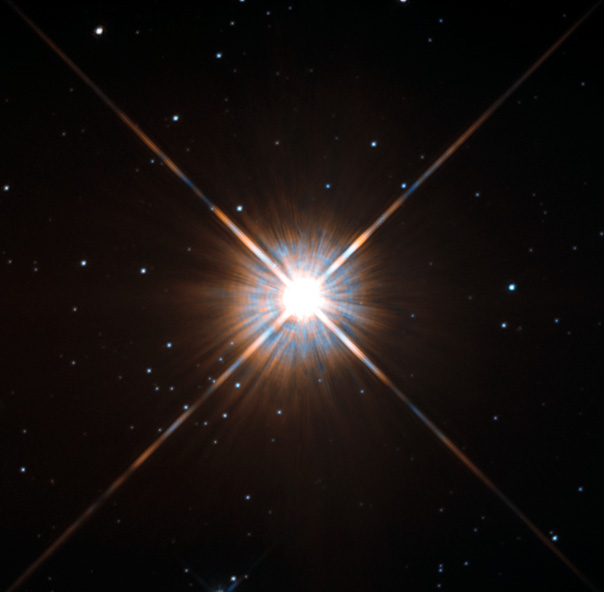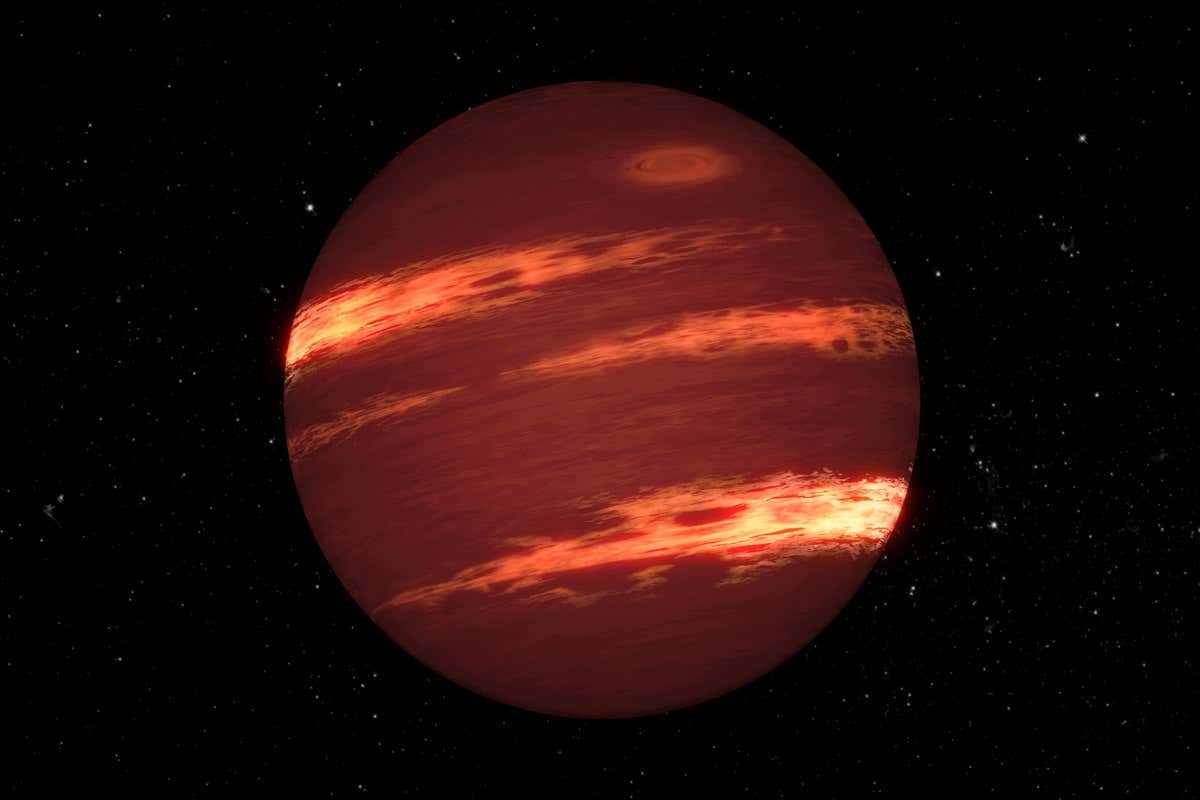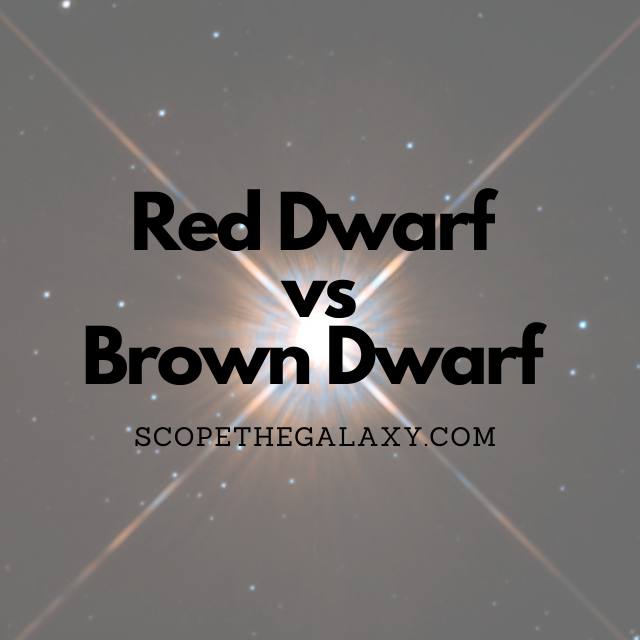*This post may contain affiliate links. This means we may make a commission if you purchase an item using one of our links*
Red dwarfs are the smallest main sequence stars in our universe that are able to convert normal hydrogen to helium whereas brown dwarfs are stars that are too low in mass to convert normal hydrogen, instead converting deuterium (heavy hydrogen). Due to this fact brown dwarfs are often referred to as failed stars.
For a more thorough breakdown of both dwarf stars along with the similarties and other major differences, continue reading.
What Is A Red Dwarf?
Table of Contents

A Red dwarf is a star that possesses a very low mass, meaning they have low pressures, fusion rates, and temperatures. These factors mean that Red Dwarfs only glow with a dim light, making them difficult for astronomers to spot.
Some estimates suggest that up to three-quarters of the stars in our universe could be red dwarfs – yet none are visible to the naked eye.
While this type of star only emits 1/10,000 as much light as the sun, this is still a significant amount of light – around 10 trillion gigawatts. And this limited amount of radiance gives the red dwarf a considerable advantage – it extends its life far beyond that of a star such as our sun.
The definition of a red dwarf is vague, with no specific criteria for naming a star in this way. Instead, this label is given to many of the small, cool stars in a galaxy. These include K and M dwarfs.
A red dwarf forms in the same way as many other stars. Clouds of gas and dust swirl together under a gravitational force that allows them to group at the center. Once the central temperature is significant for fusion, this process begins, and a star is born.
What Is A Brown Dwarf?

The fate of a star is determined mainly by its mass. Every star is born with significant mass that produces immense gravity and heat in its core.
These temperatures are so intense that nuclear fusion begin to act upon the elements surrounding it, providing both a source of energy and luminous look of any given star.
A brown dwarf is a star that is only a fraction the size of our sun.
Astronomers often use Jupiter as a standard measure, where for example if a stellar body were to have a mass of more than 13 Jupiters, this would mean that the celestial entity in question would then have sufficient energy within its core to spark a nuclear reaction and fall under the classification of a brown dwarf.
However, this reaction involves burning deuterium – or heavy hydrogen – rather than the regular hydrogen that fully-fledged stars use.
In order to burn ordinary hydrogen, a star needs a minimum mass of 75 Jupiters. Anything that sits within these upper and lower limits can be considered a brown dwarf.
In essence, a brown dwarf is a stellar object that sits between the mass of a large planet and a small star with insufficient mass to sustain nuclear fusion. A brown dwarf can also be called a “failed star.”
From a distance, brown dwarfs may share a similar appearance to a red dwarf, but red dwarfs fuse and convert ordinary hydrogen which is what differentiates them from a brown dwarf.
Similarities Between Red Dwarfs And Brown Dwarfs
Both red dwarfs and black dwarfs are classified as stars as both convert and burn a form of hydrogen within its core to helium. Both stars are able to produce light and produce energy.
Therefore, both are made up of hydrogen, helium among other ionized elements, generally within a nebula, where the dust clouds clump together, untill tthe gravity is so intense it forcefully creates the initial stages of a star.
Differences Between Red Dwarfs And Brown Dwarfs
The differences between the 2 would include the following:
- Red dwarfs are hotter than brown dwarfs as they tend to be around 3,500 degrees celsius whereas brown dwarfs are a far cooler 125 – 175 degrees celsius.
- Red dwarfs are far brighter than brown dwarfs.
- Brown dwarfs are failed stars as they convert heavy hydrogen aka deuterium within its core unlike red dwarfs that burn normal hydrogen like most other main sequence stars.
- Brown dwarfs will not leave behind a dead stellar white dwarf remnant as they are already classified as dead stars whereas red dwarfs will eventually leave behind a white dwarf remnant.
- Red dwarfs are roughly between 13 – 75 Jupiter’s in mass whilst red dwarfs are between 75 – 500 Jupiter’s in mass. If broken down into solar masses, that hat would equate to 0.013 – 0.075 for brown dwarfs and 0.075 – 0.5 for red dwarfs
- Red dwarfs are said to have a theorised lifespan of upto 10 trillion years plus with the smaller red dwarfs living on the longer end whilst brown dwarfs tend to stop shining within 10 milliion years and may stop converting deutrium in less than a million years, roughly around the 200,000 – 300,000 year mark.
Summary
The main differences between red and brown dwarfs is that one is an active main sequence star and the other a failed star.
One is very hot whilst the other displays less than a tenth of the heat, red dwarfs are also more dense than your average brown dwarf, with a lifespan in the 10 trillion years range whilst brown dwarfs may shine for 10 million years on their upper end.
Despite sharing the dwarf anchor, red and brown dwarfs are completely different from how they function to what they become after they’ve stopped converting hydrogen.

